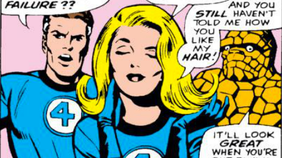Storm: Community and Colonialism
- hannahlien
- Feb 25, 2015
- 3 min read
I chose to follow Storm’s solo title for the floppy serial that I would be following for my blog. I picked up Storm #8 up last week, but was unable to read it until now due to personal obligations.
I wanted to read the Storm comic mainly because she has been one of my favorite superheroes since I was a child. I’ve liked the X-Men for a long time (I believe I was introduced to the character first through the X-Men Evolutions TV show that aired in the early 2000’s), and Storm always struck me as being one of the coolest. I mean, she can control the weather to the point of godhood. (I’m not saying that Storm could take Thor…but Storm could totally take on Thor).
All right! On to the comic itself!
I came into the series at a point where Storm is being tracked down by the government for allegedly attacking a plane and for definitely kidnapping a senator. This is not a new trope for comics. The industry has profited quite a lot on story lines where the hero is mistaken for a villain. However, I think that it makes for a striking cover image by Stephanie Hans, wherein Storm is standing before a wall plastered with burning wanted posters featuring her face.

The comic begins with a group of black citizens protesting the call for Storm’s arrest. I really like this image, because not only does it show citizens refusing to accept that a known superhero would really do something wicked. Furthermore, knowing that Storm is a mutant, an oppressed group within the Marvel universe, as well as black woman, it draws a line of solidarity and intersectionality within the story. Greg Pak emphasizes the importance of this solidarity later in the comic when Storm muses that the Utopia built by the X-Men near San Francisco was destroyed by “fighting amongst ourselves. I shouldn’t have been surprised. It’s what I’ve seen all my life wherever I go… Oppressed people destroying each other instead of their overlords,” (8). However, Pak implies throughout the comic that this is changing. Storm has been embraced by the people despite her mutant-hood and despite the condemnation of the government.

This issue ends with Storm, name cleared stepping out into the street, declaring that despite the danger that comes with trying to change the world, that there are some consequences that she could get used to (21). In the large middle panel of this same page, artist Al Barrionuevo portrays a victorious Storm being embraced by the same citizens that protested against the government in the beginning.The people are proving what Storm did not think was possible early in the issue. Banding together, the people that Pak portrays know who has their best interests in mind and behave accordingly.
Furthermore, it is necessary to note that the villain of the comic, and the one to frame Storm for his crimes is a white man that gives his motivation as trying to gain back the 14% in assests he lost. Apparently Storm's heroic activities have been costing him money. Harmon, becomes emblemic of a colonialist villain, ready to stomp on people in the developing world for the sake of a profit. "You've been running around trying to change the world," Harmon complains, "...But you don't know how the rest of us feel. Most people I know like the world just the way it is," (14.2). Pak writes Harmon as a profiteering colonialist, angry with the way that Storm is benefiting the people that he has been exploiting. Pak's decision to have a conservative white man cast blame upon a progressive black woman adds to the racial themes within the comic as well as give it more social relevence in today's socio-political climate.

The issue ends with a shadowing figure at the bottom of the San Francisco Bay, promising that Storm will have to defend against evil once again, but for now, I believe that the emphasis was on Storm’s relationship with regular people, and especially with people of color. I will have to see if this theme of solidarity remains present in future issues.




















Comments